What are the lush green clumps of “grass” growing in the lawn?
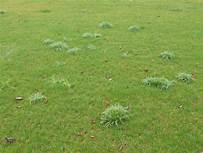 Perhaps you have pulled or dug these clumps to find a tight cluster of small white bulbs. The plant is called Star of Bethlehem (ornithogallum umbellatum) and is a member of the lily family. Unlike wild garlic and onions, this plant has no odor when crushed and is considered poisonous.
Perhaps you have pulled or dug these clumps to find a tight cluster of small white bulbs. The plant is called Star of Bethlehem (ornithogallum umbellatum) and is a member of the lily family. Unlike wild garlic and onions, this plant has no odor when crushed and is considered poisonous.
This plant can be a nuisance and is considered invasive in 10 states. A native of the Mediterranean, it was imported here as a spring flowering bulb but has since “gotten away”. It spreads easily by bulblet when soil is disturbed or tilled or when transplanting.
The best means of control is digging and disposing of bulbs in the trash. It spreads easily by bulblet when soil is disturbed or tilled or when transplanting. This bulb has become a problem for the turfgrass industry as herbicides are only partially effective.
For more information, please see this article.
How to Identify and Care for Hydrangeas ?
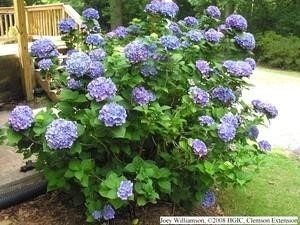 This question comes up at the hotline in both Spring and Fall. And a question the hotline team asks in return is most important. “How to Identify and Care for Hydrangeas?” Once you know what variety, then you will know when to prune. If you aren’t sure, the photos on this site will help. To access the photos please click here.
This question comes up at the hotline in both Spring and Fall. And a question the hotline team asks in return is most important. “How to Identify and Care for Hydrangeas?” Once you know what variety, then you will know when to prune. If you aren’t sure, the photos on this site will help. To access the photos please click here.
Hydrangeas bloom on new shoots that grow in the Spring or on woody stems from the previous year. Big Leaf (Hydrangea macrophyla) and Oakleaf Hydrangea (Hydrangea quercifolia) carry the blooms on the previous year’s branches or old wood.
Smooth (Hydrangea arborescens) and Tree (Hydrangea paniculate) bloom on the new Spring growth. In late winter these shrubs can be pruned down to 6-12 inches from the ground. Severe pruning will result in a smaller plant but will be rewarded with large blooms.
For climbing Hydrangea (Hydrangea petiolaris) pruning of dead or damaged wood should be all that is necessary. Even when pruned properly, if there is a severe winter or a late spring frost flower buds may have been damaged and no blooms will result. The extension organizations of UMass and UConn have more detailed information at:
What is the white flowering weed in my lawn?
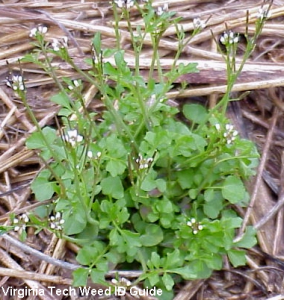 One of the first lawn weeds to be seen each Spring is called Hairy bittercress (Cardamine Hirsuita). The plant originally came from Eurasia and spread throughout North America. There are a number of species, some of which are native to The United States. Bittercress is a member of the mustard, or brassicaceae family and a favorite of foragers for its mild peppery, not bitter flavor.
One of the first lawn weeds to be seen each Spring is called Hairy bittercress (Cardamine Hirsuita). The plant originally came from Eurasia and spread throughout North America. There are a number of species, some of which are native to The United States. Bittercress is a member of the mustard, or brassicaceae family and a favorite of foragers for its mild peppery, not bitter flavor.
Bittercress germinates from seed in the fall, especially in disturbed or wet soil, shady areas or in lawns mown too short. It emerges as a rosette before sending up flowers and seeds.
Hand weeding is a good method of mechanical control, as rosettes are shallow rooted. It is best to remove before seeds form. Maintaining a healthy lawn and mowing to a height of 3 inches also helps in control. Herbicides are a last resort. Pre-emergent can be applied late Summer/ early Fall but grass seed cannot then be planted. Learn more.
What steps can I take now to make the most of my lawn this summer?
Spring lawn clean up, such as cleaning debris, raking and removing fallen sticks and leaves is a good first step for this time of year. Walk around, take stock of problem areas such as those with poor drainage or compaction. Low areas may need to be re-graded. A lawn that receives heavy traffic may need aeration if the grass roots only occupy the first 1-2 inches of soil. Soil testing to determine pH is appropriate every couple of years or annually if you have been making adjustments to raise your pH. Lime can be applied in Spring and Fall as necessary.
Information on soil testing sites can be found here: https://web.uri.edu/mastergardener/soil-testing-service/
Fall is preferred for sowing grass seed, however seeding can be done in late April if necessary. Reasons for spring seeding might include thin turf due to winter damage or poor recovery from last year’s problems. Look here for information on planting grass seed: Seeding a Turf Area in the Spring – Purdue Ext
Fertilizer should not be applied before greening of the lawn occurs. Use a reduced rate of application if seed has been applied and minimize use of fertilizers in general to reduce environmental impact. The following link provides detailed and useful information on lawn care and fertilizer use: https://web.uri.edu/safewater/protecting-water-quality-at-home/sustainable-landscaping/healthy-l awn-care/
Proper identification of weed and pest problems is essential to minimize overuse of pesticides and herbicides. If crabgrass was an issue in your garden last summer, a pre-emergent herbicide can be applied when Forsythia blooms begin to fade (soil will have warmed to approximately 50 degrees at this point). The following link describes common lawn weeds and what they mean when present: Plant Identification in Lawns and What it says about soil – URI ext
Grubs, if present will begin root feeding in April and May. Late May is the best time to treat if necessary. Treatment should only be considered when the number of grubs exceeds eight per square foot. Find information of Japanese grub life cycle here: Japanese Beetle Life Cycle
Learn more about Spring lawn care to prepare for the Summer: Lawn Renovation and Establishment – UVM Ext
When is a great time to divide perennials?
Spring is a great time to divide perennials. The shoots with leaves are not in your way, the weather is cool and less stressful on the plants and nature can help water. There are three kinds of perennial root systems: spreading roots like bee balm or daisies, clumping roots like day lilies and rhizome roots like iris. A perennial clump needs division if the center is dead or has stunted growth, or if there are fewer and smaller flowers and there is little bottom foliage. Take a sharp spade and cut the spreading roots such as daisies vertically in small clusters and remove with small root ball, or divide with two garden forks. Fill in the hole with compost. Plant and water root division in another spot in the garden or in a pot to give to a friend. Clumping roots like day lilies or hosta may be cut with a spade vertically or more gently with a trowel. Be sure each new clump has several sprouts or eyes for shoots. The rhizome roots like bearded iris should be dug up, old rhizome cut and discarded with new healthy root planted. Some perennials should be divided every year like bee balm or mint, some plants never need division like peony and most need division every three years.
What should I do if there’s winter damage to my shrubs?
Injury to shrubs and trees during the winter can result from exposure to drying winds, low temperatures, and late frosts and freezes. Symptoms can include leaf scorch, especially in plants that are in their northern limit, salt injury or browning of new growth that may have started in response to warm temperatures in February or March. Damage to flower buds and branch dieback may occur as well as frost cracks on exposed bark, usually on the south side of the trunk.
Management includes cultural practices that conserve moisture, prevent root damage, and allow for hardening off prior to winter. Avoid late summer fertilizing which stimulates late growth and gives inadequate time for the plant to harden off before cold temperatures ensue. Watering should be a deep soak of several inches, and allow to dry well between waterings. Prune now to remove dead, damaged or broken stems and to stimulate new growth.
How should I prune Rhododendron and Azalea to keep in top shape?
Spring in Rhode Island is ablaze with the myriad colors of azalea and rhododendron cultivars. Azaleas have both evergreen and deciduous varieties but all are in the genus Rhododendron.
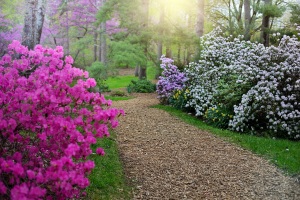 Occasional pruning is necessary if the plant has outgrown its intended space or to maintain compact growth and shape. Pruning is best done in spring when flowers fade. Later pruning can be done anytime it is not freezing but will remove new buds and and result in a loss of color next spring. Use clean, sharp pruning tools. Remove dead branches and prune taller branches to open the center of the plant to light and air but maintain overall symmetry. Overly large plants may be cut back in winter to about 12 inches and will develop with a flush of new growth by spring. A specimen pruned so drastically will take several years to recover. The North Carolina Cooperative Extension has more detailed information at: Pruning Calendar – NCSU Ext
Occasional pruning is necessary if the plant has outgrown its intended space or to maintain compact growth and shape. Pruning is best done in spring when flowers fade. Later pruning can be done anytime it is not freezing but will remove new buds and and result in a loss of color next spring. Use clean, sharp pruning tools. Remove dead branches and prune taller branches to open the center of the plant to light and air but maintain overall symmetry. Overly large plants may be cut back in winter to about 12 inches and will develop with a flush of new growth by spring. A specimen pruned so drastically will take several years to recover. The North Carolina Cooperative Extension has more detailed information at: Pruning Calendar – NCSU Ext
What are some of the best options for mulch?
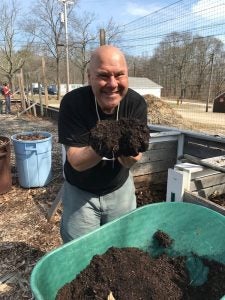 Mulching is the best time saving measure a gardener can do. Mulched beds keep soil cooler in summer and warmer in the winter which is less stress to the plants. Mulches help retain moisture and control weeds. There are so many types of mulches; it is important to have the right mulch for the job. Organic mulches like shredded bark, compost or hay and inorganic mulches like stone, brick and black plastic have a place in the landscape. A good example of a wonderful mulch is shredded red cedar. It naturally repels insects so it is a good choice near a house foundation. But it is not good with flower or vegetable plants as it repels all the pollinators! A tree can benefit from a good mulch, however application is important. Volcano mulch against the trunk causes rot and an invitation to fungal infections. And yes, you have to weed or hoe before applying 2-3” of mulch. For more information on mulch, please visit:
Mulching is the best time saving measure a gardener can do. Mulched beds keep soil cooler in summer and warmer in the winter which is less stress to the plants. Mulches help retain moisture and control weeds. There are so many types of mulches; it is important to have the right mulch for the job. Organic mulches like shredded bark, compost or hay and inorganic mulches like stone, brick and black plastic have a place in the landscape. A good example of a wonderful mulch is shredded red cedar. It naturally repels insects so it is a good choice near a house foundation. But it is not good with flower or vegetable plants as it repels all the pollinators! A tree can benefit from a good mulch, however application is important. Volcano mulch against the trunk causes rot and an invitation to fungal infections. And yes, you have to weed or hoe before applying 2-3” of mulch. For more information on mulch, please visit:
- Types and Uses of Mulch – Cornell Ext
- To Mulch or Not to Mulch – KS State Ext
- Mulching Landscape Trees- Penn State
- Springtime Mulching – VA Ext
I have invasive Asiatic bittersweet growing on my property. What can I do?
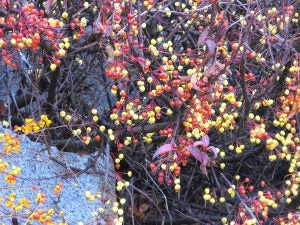 Asiatic bittersweet poses a serious threat to other species and to whole habitats due to its aggressive habit of twining around and growing over other vegetation. This plant has a high reproductive rate, long-range dispersal mechanisms, and the ability to root-sucker. The vines can strangle tree and shrub stems. All types of plants, even entire plant communities, can be over-topped and shaded out by the vine’s rapid growth. Nearly pure stands of this vine are sometimes found in affected areas. If the bittersweet infestation is light, hand-pulling vines can be effective, especially before the vines have fruited. Place vines in plastic trash bags and dispose of them, or bake the vines in the sun on a tarp or on a paved surface to kill the roots and seeds. Bittersweet often resprouts from root fragments, so use care to remove as many roots as possible to avoid regrowth. Heavier infestations may be controlled by cutting stems and painting them with an herbicide in early summer through winter. Now is a great time to pull up the seedlings. You will know you pulled the right plant by the distinct orange root. Interested in Invasive Plant Management Training? Visit URI Cooperative Extension’s webpage for information and to access the database of certified landscapers: https://web.uri.edu/coopext/ipmcp/
Asiatic bittersweet poses a serious threat to other species and to whole habitats due to its aggressive habit of twining around and growing over other vegetation. This plant has a high reproductive rate, long-range dispersal mechanisms, and the ability to root-sucker. The vines can strangle tree and shrub stems. All types of plants, even entire plant communities, can be over-topped and shaded out by the vine’s rapid growth. Nearly pure stands of this vine are sometimes found in affected areas. If the bittersweet infestation is light, hand-pulling vines can be effective, especially before the vines have fruited. Place vines in plastic trash bags and dispose of them, or bake the vines in the sun on a tarp or on a paved surface to kill the roots and seeds. Bittersweet often resprouts from root fragments, so use care to remove as many roots as possible to avoid regrowth. Heavier infestations may be controlled by cutting stems and painting them with an herbicide in early summer through winter. Now is a great time to pull up the seedlings. You will know you pulled the right plant by the distinct orange root. Interested in Invasive Plant Management Training? Visit URI Cooperative Extension’s webpage for information and to access the database of certified landscapers: https://web.uri.edu/coopext/ipmcp/
More Information:
What is damaging my rose leaves?
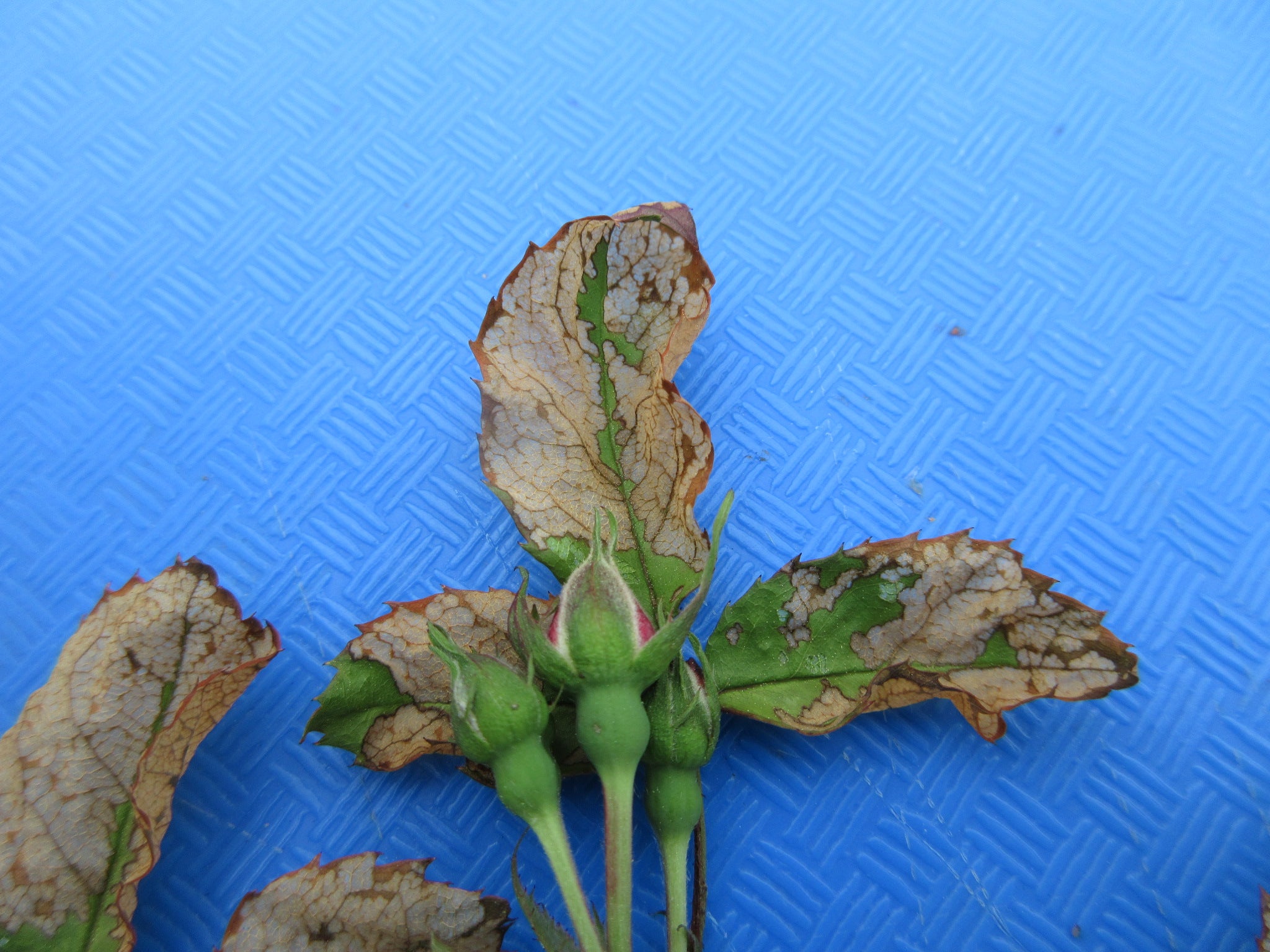 You might be noticing some rose leaves have been stripped down to the stems and veins. This may be the handiwork of the Rose sawfly larvae, sometimes called rose slugs. The larva feed on the soft tissue on the undersides of leaves. A mild infestation will not damage the plant but a large number of slugs can stress the plant, making it susceptible to other damaging pests. Begin checking for these insects mid Spring. Control light infestations by removing damaged leaves and hand picking larvae. A forceful spray of water can dislodge insects as well.
You might be noticing some rose leaves have been stripped down to the stems and veins. This may be the handiwork of the Rose sawfly larvae, sometimes called rose slugs. The larva feed on the soft tissue on the undersides of leaves. A mild infestation will not damage the plant but a large number of slugs can stress the plant, making it susceptible to other damaging pests. Begin checking for these insects mid Spring. Control light infestations by removing damaged leaves and hand picking larvae. A forceful spray of water can dislodge insects as well.
What are the spots I am seeing on my plants?
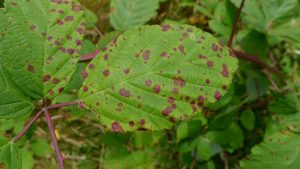 This spring we have had unusually humid, wet and cloudy weather- perfect growing conditions for fungal infections. For problems on peonies, tomatoes, privet, grapevines, birch trees, all in one day, we have suggested treatments to include improving air circulation, cleaning up and disposing of infected plant material, and avoiding overhead irrigation. If you see spots, consider fungus!
This spring we have had unusually humid, wet and cloudy weather- perfect growing conditions for fungal infections. For problems on peonies, tomatoes, privet, grapevines, birch trees, all in one day, we have suggested treatments to include improving air circulation, cleaning up and disposing of infected plant material, and avoiding overhead irrigation. If you see spots, consider fungus!
Ohio State University Extension has a useful fact sheet: Fungal and Fungal Like Diseases of Plants – OH Ext
How do I prevent powdery mildew?
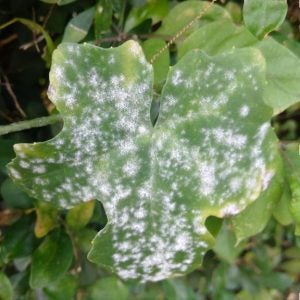 Powdery mildew is one of the most widespread and easily recognized plant diseases. Although plant host specific, there are species of powdery mildew that can effect many different plants. High heat and humidity favor development, though mildew will not grow when leaves are wet. Crowded plantings and shady damp areas enhance the risk of powdery mildew. Prune to improve air circulation and avoid overhead watering to reduce relative humidity. Young succulent growth is most susceptible, so avoid late summer application of nitrogen fertilizer. The fungal spores typically overwinter in soil, so remove and dispose of all infected plant materials (not in the compost). The following factsheets from Colorado State University and UMASS Ext have more detailed information:
Powdery mildew is one of the most widespread and easily recognized plant diseases. Although plant host specific, there are species of powdery mildew that can effect many different plants. High heat and humidity favor development, though mildew will not grow when leaves are wet. Crowded plantings and shady damp areas enhance the risk of powdery mildew. Prune to improve air circulation and avoid overhead watering to reduce relative humidity. Young succulent growth is most susceptible, so avoid late summer application of nitrogen fertilizer. The fungal spores typically overwinter in soil, so remove and dispose of all infected plant materials (not in the compost). The following factsheets from Colorado State University and UMASS Ext have more detailed information:
What can I do to manage/ prevent basil downy mildew?
Now that we are having hot and humid weather, we are getting calls about all sorts of downy mildews. The Basil Downy Mildew is a quick-killing heartbreak for home growers. It starts with yellowing of the leaves,and quickly turns the undersides of the leaves fuzzy and gray. It is caused by Peronospora belbahrii, and thought to be spread by airborne dissemination from infected plants. Infected plants should be removed and destroyed (the spores cannot survive our winters). Visit the following links for more information.
How do I maintain a healthy lawn during the late summer and early fall?
Many lawns are showing stress from hot dry weather. Turfgrass management at this time is extremely important to maintain a vigorous lawn or to make repairs.
- Mowing should continue until grass is dormant but lower blade to 2 ½ inches as weather cools in Fall.
- Thatch that is over ½ inch deep should be removed
Aerate in compacted areas, such as areas of heavy foot or vehicle traffic or where drainage is poor - Fertilize with 1-2 pounds of Nitrogen per 1000 square feet, particularly after dethatching or aeration
- Seeding may begin in mid August, weather depending, through September 30. Fall is an ideal time to reseed or overseed an existing lawn or to plant a new lawn
- Broadleaf weed control is more effective at this time of year than in Spring or Summer. As always use only according to manufacturer’s directions and only where necessary.
Iowa State has more detailed information at: https://hortnews.extension.iastate.edu/1994/7-29-1994/lawn.html
What is a wild cucumber vine?
Wild Cucumber Vine (echinocystis lobata) is an annual member of the cucumber family and a native plant that can quickly grow to 25 feet. The vine forms spiky “cucumber” pods that explode when ripe. It can be cultivated as a native wildflower but its aggressive growth covering trees can be troublesome. It is easily hoed at the ground and it is best to remove seed pods so the plant does not reproduce next year. More information can be found at:
How do I care for my perennials in the fall?
1.  Cutback: Leave stems to trap snow and provide both winter interest and food for the birds. Daylily, Hosta and Peony are best cut back to the ground and debris removed to reduce disease and insect pests. Dispose of (do not compost) diseased material. Please see the following from Penn State for in-depth information: Cutting Down Perennials in the Fall – PSU Ext
Cutback: Leave stems to trap snow and provide both winter interest and food for the birds. Daylily, Hosta and Peony are best cut back to the ground and debris removed to reduce disease and insect pests. Dispose of (do not compost) diseased material. Please see the following from Penn State for in-depth information: Cutting Down Perennials in the Fall – PSU Ext
2. Divide: Now is the time to take stock of perennial beds and decide what needs to be divided and moved. September to mid October (4-6 weeks before the ground freezes) is the ideal time to divide Spring and Summer flowering perennials. Most perennials benefit from division every 3-4 years. UMN has good tips on dividing perennials: UMN -Ext
3. Dig and store tender bulbs and plant and fertilize Spring flowering bulbs
4. Weed, edge and water as necessary
5. Label plants for early spring identification
6. The University of Vermont has more timely tips, including adding compost or mulch here: UVM -Ext
How do I identify and control poison ivy?
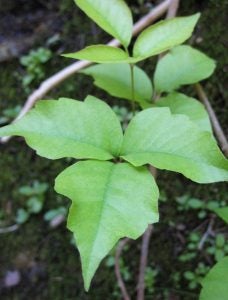 Toxicodendron radicans, or poison ivy, is a native plant with three shiny irregular leaflets. Mature vines can be hairy ropes growing up trees while younger plants in the sun can be like a shrub. Small white flowers produce white berries which are considered good for wildlife. Leaves and stems contain urushoil oil which causes a rash in 85% who contact it. The oil stays active for three years, even in dead plants and will transfer from pets to people or gloves to face. Always protect yourself with gloves and long sleeves and wash afterwards. For more information on control of poison ivy, see the Extension resources below:
Toxicodendron radicans, or poison ivy, is a native plant with three shiny irregular leaflets. Mature vines can be hairy ropes growing up trees while younger plants in the sun can be like a shrub. Small white flowers produce white berries which are considered good for wildlife. Leaves and stems contain urushoil oil which causes a rash in 85% who contact it. The oil stays active for three years, even in dead plants and will transfer from pets to people or gloves to face. Always protect yourself with gloves and long sleeves and wash afterwards. For more information on control of poison ivy, see the Extension resources below:
What are the large wasp-like insects that are digging holes in the ground?
Wasps as large as hummingbirds? We have had several calls to the hotline about a large digging wasp that creates holes in the ground and displaces large amounts of soil or sand. This is Sphecius speciosus, commonly called the “cicada killer” for the fact that it kills cicadas to provide for their young. Female cicada killer wasps sting a cicada in the air, which paralyzes it. They then lay an egg in the cicada and place it in a nest in the ground where the immature will develop. They prefer well- drained, light-textured soils in full sunlight that are near trees harboring cicadas.
This wasp is active from mid-July to late September in our area, coinciding with the presence of annual or dog-day cicada. The wasps form solitary nests; they do not form colonies. Males will aggressively defend their territory and can be very frightening but lack stingers. Females can give a painful sting but typically only do so when handled or threatened. Cicadas are a plant pest, although a minor one, so the cicada killer can be considered a beneficial insect. There are cultural control measures that can be helpful which consist of
eliminating the bare patches that the wasps use to form their nests. Watering these areas heavily can also cause wasps to abandon their nests.
Cicada killer wasps can be particularly problematic in playgrounds, sand traps, or parks and sometimes make an unsightly mess of lawns. NC State has photos and additional information: Cicada Killer Wasps – NCSU Ext
If necessary, permethrin dusts can be applied directly to the holes. It will cling to the body of the female wasp as she enters and exits nests and be ingested when she cleans herself. As always, use pesticides with caution and according to manufacturer’s instructions. The University of Kentucky has more information here: https://entomology.ca.uky.edu/ef004
How do I identify and control black swallow-wort?
Black swallow-wort is an herbaceous perennial native to southwestern and northern Europe. It grows as a twining vine with a clear watery sap. The leaves are opposite, shiny, dark green and narrowly oval or heart-shaped with smooth margins. The stems have downy hairs. Black swallow-wort has small dark purple flowers with 5 triangularly shaped petals. They develop milkweed-like pods that split when the seeds are ripe. Swallow-worts thrive in a wide range of settings. The leaves turn a conspicuous yellow in late summer. Monarch butterflies may mistakenly lay their eggs on black swallow-wort because swallow-worts are members of the milkweed family. However, monarch caterpillars are not able to feed on this weed and will die after feeding on swallow-wort plants..Many insects avoid feeding on swallow-worts because they are toxic and distasteful. Swallow-wort is also toxic to deer and livestock.
Small infestations of swallow-wort can be controlled by mechanical means, but larger areas require a multi-year, multiple strategy effort. Plants may be dug, being sure to remove the entire root crown and not left on the ground or composted. Pods can be removed to prevent seed spread. Mowing alone promotes sprouting from the root crown but mowing multiple times in one season, or in conjunction with herbicide sprays can be effective. Herbicides should be applied before pods begin to form. Field releases of the leaf-eating moth species Hypena opulenta for biological control have just begun on an experimental basis in Rhode Island, Massachusetts, Connecticut, New York, and Michigan.
For more information, follow these websites
